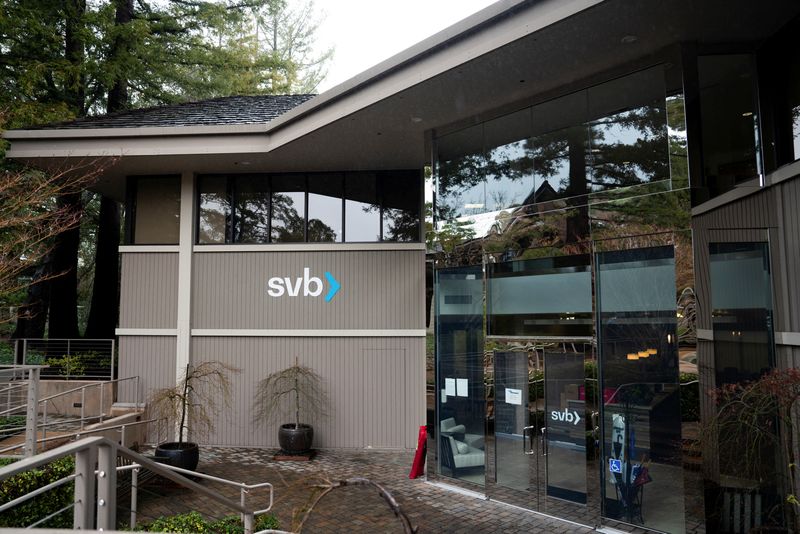By Howard Schneider
WASHINGTON (Reuters) -Earlier this month the U.S. Federal Reserve in a report to Congress gave what has become a standard reassurance: Banks were strong and the overall financial system in solid shape.
That confidence is now being tested as the Fed and other regulators watched the failure of Silicon Valley Bank last week rapidly morph into a potential systemic shock, threatening to undermine confidence in bank deposits and touch off more destabilizing runs.
Just days after delivering the all clear to Congress, the Fed rolled out a crisis playbook honed during the housing collapse in 2008 and expanded during the Covid-19 pandemic, announcing its latest go-big and go-fast effort to keep the financial system stable.
Banks will now be allowed to borrow essentially unlimited amounts from the Fed as long as the loans could be collateralized with safe government securities, a way to prevent financial firms from having to sell a class of investments that have been losing value because of the Fed's own high interest rate policies.
The response from regulators on Sunday also included a pledge to make whole all depositors, even those with accounts above the Federal Deposit Insurance Corp's standard $250,000 limit, at Silicon Valley Bank and a second smaller institution, Signature Bank (NASDAQ:SBNY), that failed over the weekend.
By allowing loans for a year against the full face value of government bonds and mortgage backed securities, banks will be able to "easily leverage (the new Fed facility) to access liquidity, rather than have to realize significant losses and flood the markets with paper" they are forced to sell to meet depositor demands, economists from Jefferies wrote. "Monday will surely be a stressful day for many in the regional banking sector, but today's action dramatically reduces the risk of further contagion."
The Fed has standing programs that are always available to shore up the financial system, including direct loans to banks with adequate collateral through its so-called discount window. The Fed made changes at the start of the coronavirus pandemic to encourage such borrowing, some of which, including a lowered interest rate on discount window loans relative to its benchmark policy rate, remain in place.
But in this case, as in crises dating back to the 2007-to-2009 housing collapse, the discount window was considered inadequate to address the developing risks, problems that to some degree stemmed from the Fed's own aggressive monetary policies.
SVB's collapse highlighted whether the Fed's aggressive rate increases, which took rates from near zero percent a year ago to more than 4.5% today, had finally caused something important to "break" as holders of low-yielding Treasury bonds face capital losses and banks, particularly smaller ones, faced tougher terms to attract the deposits needed for operations.
'IDIOSYNCRATIC'
Fed officials have been surprised to some degree by how little turmoil their rate increase have triggered until now, with some policymakers saying the lack of clear stress made them more inclined to keep raising rates as they work to tame inflation.
That may change now, with some analysts suggesting it could tilt the Fed toward a lower endpoint in its rate-hiking cycle.
The initial sense was that SVB's problems were "idiosyncratic," as Bank of America (NYSE:BAC) analysts put it, with others noting that markets still looked at the largest financial institutions as immune from fallout. Those firms in particular are buffered by the higher levels of capital under reforms enacted a decade ago to cushion them against failure.
When it was closed Friday, SVB had a balance sheet of around $200 billion and was the country's 16th largest bank. That is far from the league of the large, systemic players, but big enough to rattle the stock prices of other mid-sized institutions and prompt calls for depositors to be protected beyond the Federal Deposit Insurance Corp's standard $250,000 limit.
The concern was the type of herd behavior that might develop if SVB's depositors faced losses, and confidence began to erode more broadly.
The Fed's response was described by Fed officials as classic central banking, lender-of-last-report behavior - offering funds on a virtually unlimited basis against safe collateral.
But it also was framed by the lessons and restrictions of prior crisis. The situation had to be judged systemic, a finding unanimously endorsed by the Fed's Board of Governors, Treasury Secretary Janet Yellen, and others.
Its structure was meant to match the size of the problem, potentially big enough, Fed officials said, to match all currently uninsured deposits - which amounted to more than $9.2 trillion across the banking system at the end of last year - should account holders march en masse to their bank and demand their money.
Yet it also highlighted the still limited scope regulators have on how and where potential crises may develop.
SVB's collapse appears driven by the sort of rate and funding dynamics the Fed watches for in semiannual reports devoted to financial stability and in documents like the Monetary Policy Report to Congress delivered earlier this month.

In its report to Congress on March 3, that funding risk was judged "low" in the system overall.
"Large banks continue to have ample liquidity to meet severe deposit outflows," the Fed report said. "Against the backdrop of a weaker economic outlook, higher interest rates, and elevated uncertainty over the second half of the year, financial vulnerabilities remain moderate overall."